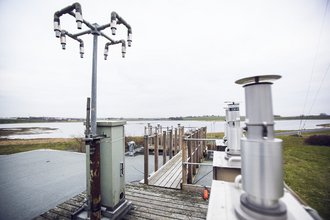Direct adress to the current web page envs.au.dk/air

Use the menu on the left to find results of air pollution monitoring, inventories of Danish emisssion to the air, information on air pollution models and much more.
A remarkable new service launched in 2016 is "Air Quality at your Street" (opens in new window). An interactive map shows air pollution in Denmark in general and in detail, even to the level of each single address (the service is currently in Danish only).
Air pollution has a substantial impact on health, Nature and climate. Issues currently in focus in Denmark are population exposure to particle pollution, and nitrogen deposition to sensitive parts of our countryside and to marine areas. On a worldwide level, the most serious problem is the emission of CO2 (carbon dioxide) and other greenhouse gases that can contribute to global warming.
The topic of Air Pollution is a "Research flagship" at Aarhus University, meaning that it is a high priority area, and that internationally recognized research of high quality is conducted.
The research involves studies of the physical, chemical and biological processes in the atmosphere governing inorganic, organic and biological environmental constituent. It further includes how these constituents affects health, environment and climate in different parts of the world, but mainly in Denmark, Europe and the Arctic environment.
Focus is particularly on the subject of air quality and health, including research on the effect of airborne particles on health. Thus, ”Atmospheric pollution and impacts on human health” is defined as a so-called “Strategic Growth Area” at the Department of Environmental Science.
Aarhus University (AU) conducts field studies of air pollution and climate parameters in Denmark as well as internationally in close cooperation with other research groups. Work with mathematical models that can describe how air pollutants are transported, converted and deposited is an area where AU has a strong international position. These models have a level of detail that ranges from local pollution in a street to nationwide and global air pollution.
Aarhus University manages national Danish data reporting in accordance with international conventions such as the Climate Convention and the Geneva Convention on Long-Range Transboundary Air Pollution, as well as reporting to the European Environment Agency.
Over a period of many years, AU has developed special expertise in combining measurements and model calculations to describe and assess air pollution and its impact on humans and nature.
AU has a strong presence in the Arctic, as it operates the arctic research facility Villum Research Station in North East Greenland.
Research regarding air pollution and emissions is primarily carried out in the following sections of Department of Environmental Science:
DCE – Danish Centre for Environment and Energy provides consultancy services for the public sector and other bodies regarding air pollution and emissions in the areas of:
DCE offers services and consultancy to other public and private sector customers in all its areas of expertise. All consultancy services are based on internationally acknowledged research.
We can supply data, model tools for calculating air pollution, and expertise for assessing the extent of different problems in order to solve them most efficiently.
You can find more information about DCE’s consultancy services here.